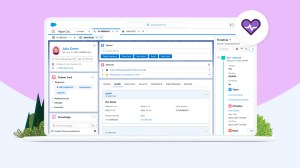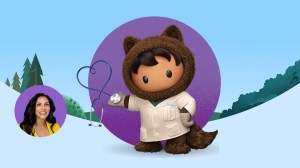We’re a year into the global pandemic and just a few months into the world’s largest-ever vaccine rollout. Health providers on the front lines of administering vaccines have risen to the challenge on a massive scale, inspiring us deeply.
Penn State Health is one of these providers. They’re using Salesforce to register patients, schedule appointments, and manage inventory across 29 counties in Pennsylvania. We sat down with Cletis Earle, Senior Vice President and Chief Information Officer, and Sean Young, Senior Vice President and Chief Marketing Officer, to hear how Salesforce technology has enabled Penn State Health to more efficiently and equitably manage vaccine data and distribution.
Q: What were some of the challenges Penn State Health experienced as a result of the pandemic?
Sean Young: The pandemic changed the way we do business and serve patients, which has presented both challenges and opportunities.
In the past year, we’ve moved to a remote workforce, built a COVID-19 testing program, and recently, transitioned into vaccine administration. It’s been challenging to balance both short and long-term priorities — creating new programs that address the immediate health needs of our patients while continuing to grow and position our health system to be successful in the years to come.
Cletis Earle: Before the pandemic, we were very much tied to the office, so serving our patients and doctors remotely was a big shift for us. We needed to build the right infrastructure that allowed administrative employees working from home to properly support our essential workers who continued working from our hospitals.
The pandemic also gave us the opportunity to extend our visits and tools so we could care for our patients from anywhere. We built a virtual visit program, and Salesforce technology played a pivotal role in making this possible.
Q: Why did you choose to deploy Salesforce to power your vaccine distribution program?
Cletis Earle: We had to work quickly to ensure we were able to begin vaccinating our communities as soon as we had vaccines available and didn’t have the option to wait to implement. Salesforce Professional Services got us up and running in a matter of weeks, which is a process that would normally take several months.
We are a large academic health system with around four million Pennsylvanians in our catchment area. We selected Salesforce because it’s a nimble platform that can easily adapt to our business and workflow. It gave us a resolute system that allowed us to scale to have thousands of people connecting to our sites.
We looked at several technology options. We chose the Salesforce platform to integrate into our infrastructure because we knew we wouldn’t be bound by the limitations other health systems have had by doing the groundwork all themselves.
“We had to work quickly to ensure we were able to begin vaccinating our communities once we had vaccines available and didn’t have the option to wait to implement.”
Cletis Earle
Q: How are Salesforce tools being deployed to help manage Penn State Health’s vaccine administration program?
Sean Young: We’re using multiple Salesforce tools, including Salesforce Health Cloud and Marketing Cloud, for things like registration, scheduling, administration, vaccine management, and now, reporting to the Department of Health website. Our vaccine inventory is changing by the minute, so Salesforce technology shows us what is available in real-time. We can easily manage supply and even send personalized messages to eligible patients to let them know when appointments are available.
“Right off the bat, Salesforce supported us in getting up and running to facilitate thousands of vaccinations, while even making real-time improvements.That’s when we really knew we’d selected the right technology platform.”
Sean Young
Q: What have you learned from the COVID-19 vaccine distribution process, from a technology or cultural standpoint?
Sean Young: It’s important to remember that there was no previously established strategy that was sufficient for our health system to meet the current public health challenge. Like other health systems, we were facing an unprecedented and extremely challenging set of expectations around vaccine distribution. Our team needed to stand up a program almost overnight to administer COVID-19 vaccines safely and effectively.
Right off the bat, Salesforce supported us in getting up and running to facilitate thousands of vaccinations, even making real-time improvements.That’s when we really knew we’d selected the right technology platform.
Cletis Earle: Agility has been critical for us. We’ve frequently had to shift program needs to best support our patients and teams, especially as Department of Health guidance evolved and vaccines were approved by the FDA. The decision to pick the Salesforce platform that was not embedded or part of the EMR [electronic medical record] was significant because it gave us the capability to capture and manage information that we are able to pressure-test on the fly.
We serve diverse communities across Central Pennsylvania, so the fair and equitable distribution of vaccines is very important to us.. Salesforce’s solutions are flexible enough for us to see the data, plan out what could be improved upon, come up with a new game plan and implement improvements to our vaccine appointment capabilities within as little as 24 hours.
Q: How has the pandemic shaped Penn State Health’s digital transformation for the future?
Cletis Earle: Before the pandemic, we had a “10, 20, 30 principle” ingrained in our culture — our goal has been to ensure that patients were always 10 minutes from our primary care services, 20 minutes from a specialist and 30 minutes from an acute care hospital. Because of telemedicine, we added a 0 to that, which meant enhancing our ability to provide near instantaneous connectivity to services through virtual care.
This shift required us to rely on virtual tools that allow us to take care of patients even when they’re no longer in the health system or at a physical location.
The pandemic has also given us a renewed sense of teamwork and community. There’s a lot to get done while fighting a pandemic, so we have to lean on each other. If we’re implementing a technology solution, we need it to be extremely collaborative — and that’s what we found in Salesforce.















